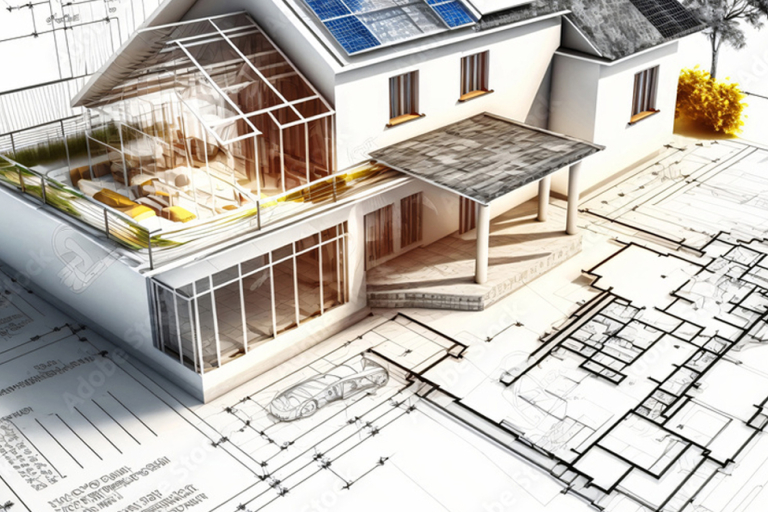Welcome to the world of construction where innovation meets profitability! In this journey, we'll explore the exciting realm of BIM for residential construction. Imagine a tool that not only helps build homes but also maximizes profits. We'll unravel the magic behind optimizing profitability with BIM in the context of residential construction, breaking down complex ideas into simple words. Let's embark on a journey where smarter technology meets smarter business decisions, all with the goal of building homes and boosting the bottom line.
Challenges of Using BIM for Residential Construction
Cost
One of the biggest roadblocks is the upfront cost of BIM software and training. For small contractors and builders, investing in expensive software licenses and training their workforce can be a significant financial burden. This is especially true when compared to the traditional 2D drafting methods they might be accustomed to.
Project Size and Complexity
BIM's strengths lie in its ability to manage complex projects with intricate details. However, for smaller residential projects with relatively straightforward designs, the level of detail and information captured in a BIM for residential construction model might be overkill. This can lead to over modeling, where the time and resources spent on creating and maintaining the model outweigh the benefits it provides.
Lack of Client Demand
In many cases, homeowners and residential developers might not be aware of the advantages of BIM or may not be willing to pay the additional cost associated with it. This lack of client demand can discourage builders and contractors from adopting BIM, as the return on investment might not be immediately apparent.
Limited Workforce Skills
BIM requires a different skill set compared to traditional construction methods. Workers need to be trained in using BIM software, understanding digital workflows, and interpreting 3D models. This can be a challenge for smaller companies that might not have the resources or time to invest in employee training.
Interoperability Issues
Even when different stakeholders on a project use BIM, they might be using different software with varying levels of compatibility. This can lead to interoperability issues, where sharing and exchanging information between models becomes difficult and time-consuming.
Data Management and Security
BIM models contain a wealth of project data, including sensitive information like material costs, subcontractor quotes, and even floor plans. Managing and securing this data can be a challenge for smaller companies that might not have robust IT infrastructure in place.

Read more: Exploring Key Challenges of BIM in Construction and Mastering the Solutions
Benefits of BIM for Residential Construction
Say Goodbye to Guesswork, Hello to Precision
Remember those times when blueprints didn't quite match reality, leading to costly mistakes and delays? With BIM, those days are gone. The 3D model is constantly updated with accurate measurements and real-time information, from the type of wood used in the beams to the energy efficiency of the windows. This means fewer errors, smoother construction, and a house that's exactly as you planned it.
Teamwork Makes the Dream Work: Improved Collaboration
BIM isn't just for architects. Contractors, engineers, electricians, plumbers – everyone involved in the BIM for residential construction project can access and interact with the same model. This fosters seamless communication and collaboration, preventing clashes between systems and ensuring everyone is on the same page. Imagine the electrician knowing exactly where the wires run before putting up a wall, or the plumber spotting a potential leak in the digital model before it becomes a real problem.
Save Time, Save Money: Boosting Efficiency and Reducing Waste
BIM isn't just about fancy visuals; it's a powerhouse for efficiency. The model helps identify potential problems early on, preventing costly rework later. It also optimizes material usage, minimizing waste and saving you money. Studies have shown that BIM can reduce construction time by up to 20% and lower costs by as much as 10%. That's money you can put towards those granite countertops or the landscaping you've always wanted.
Build Green, Live Green: Sustainable Design with BIM
BIM isn't just about building smarter; it's about building greener. The model can be used to analyze the energy performance of your house, helping you choose materials and systems that minimize your environmental impact. You can simulate different lighting and ventilation scenarios to optimize natural light and airflow, reducing your reliance on artificial lighting and HVAC systems. With BIM, you can build a home that's not just beautiful, but also good for the planet.

Read more: How Beneficial is BIM for Road and Highway Design?
About our Services!
Building your dream home shouldn't be stressful. With Harmony AT and BIM/ CIM modeling services, it can be a smooth, exciting journey from vision to reality.
Ready to experience the magic of BIM? Contact Harmony AT here for a free consultation and let's start building your perfect home, together.
P.S. Don't forget to share your dream home ideas with us in the comments below!
We hope this blog post gives you a clear and concise understanding of BIM and how it can benefit your residential construction project. Feel free to customize the content further to reflect your company's specific services and expertise. Remember, keep it simple, highlight the benefits for homeowners, and showcase your passion for using BIM to create beautiful, functional homes.
Categories





